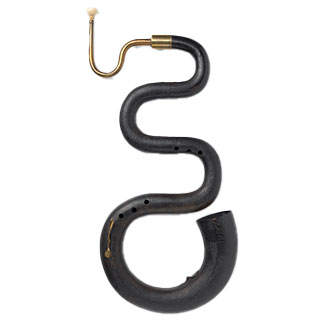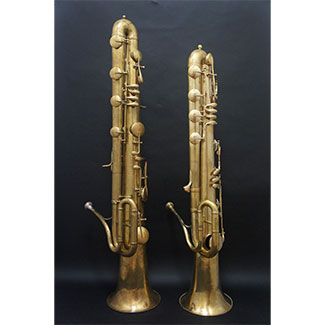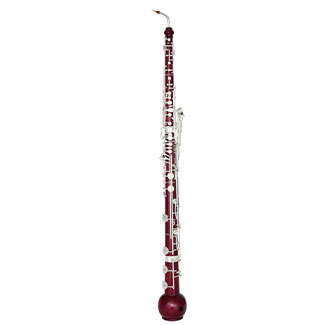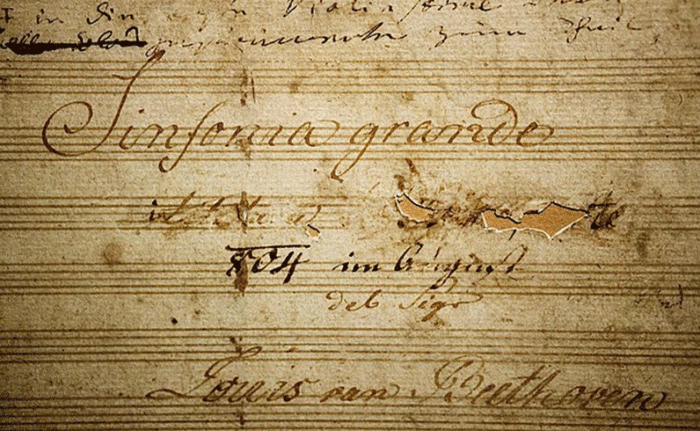Music has the incredible power to transcend time, carrying with it the stories of centuries past. The Houston Symphony has not shied away from introducing audiences to unique and rare instruments throughout history. While hundreds of instruments outside of the typical orchestral roster have been invented, only some have withstood the test of time and are still used, or acknowledged, today. In this post, we’ll delve into some fascinating instruments from history, each with its own distinctive sound and rich historical significance.
The Serpent: The Enchanting Renaissance Icon
Dating back to around 1590, the serpent was an instrument of its time, revered during the Renaissance era. Invented by Edme Guillaume, the serpent was primarily used to reinforce men’s voices in sacred music, acting as an accompaniment to the cello and bassoon. For churches that couldn’t afford organs, the serpent provided a vital alternative.
Its unique design is a curious blend of brass and woodwind features, with a mouthpiece resembling that of a brass instrument and side holes akin to a woodwind. At seven to eight feet long, the serpent’s curved body, reminiscent of a snake, adds to its distinctive appearance. While it was challenging to play and produced unexpected results, it served its purpose for nearly 200 years until being replaced by the ophicleide and eventually tuba. With a fundamental note of C and only six finger holes, mastering the serpent demanded precise adjustments in embouchure for pitch accuracy. However, despite its quirks, the serpent left an indelible mark on the music of its time.
Notable composers like Handel, Haydn, Berlioz, and Mendelssohn occasionally employed the serpent as a bass voice in their orchestral compositions. While Berlioz originally employed this instrument in Symphonie Fantastique, which you can hear on October 7 & 8 this season, the tuba now replaces its role on the modern orchestral stage.
Click here to hear the serpent by itself.
The Ophicleide: The Romantic-Era Brass Gem
In the early 19th century, Frenchman Jean Hilaire Asté introduced the ophicleide, a keyed brass instrument, which eventually replaced the serpent. The name “ophicleide” is derived from the Greek words “phis” (serpent) and “kleid” (keys), aptly describing its serpent-like origins enhanced with the addition of keys for improved playability. This innovation allowed musicians to access a wider range of notes, making the ophicleide a more versatile and expressive instrument that its predecessor. During the Romantic era, beginning around 1798 and lasting until 1837, the ophicleide gained significant popularity and found favor with renowned composers of the time. One such admirer was Felix Mendelssohn, who was captivated by the instrument’s unique timbre and included it in his compositions. Other prominent composers like Berlioz, Verdi, and Wagner also utilized ophicleide in their works.
With a three-octave range akin to the modern-day euphonium, the instrument produced a sound that resembles its contemporary brass cousins. The instrument’s bold and distinctive tone made it an attractive addition to orchestral compositions, adding depth and character to the brass section. However, despite its promising reception and initial popularity, the ophicleide’s time in the spotlight was relatively short-lived. As the 1830s approached, advancements in instrument design and musical tastes paved the way for the emergence of the modern-day tuba. This new brass instrument offered even greater range and flexibility.
Nonetheless, its unique sound continues to captivate audiences when featured in select orchestral compositions like Berlioz’s Symphonie Fantastique (sitting next to the serpent player in this clip). Mendelssohn’s A Midsummer Night’s Dream also featured ophicleide, allowing it to shine in a different musical context.
Click here to hear a quartet of ophicleides playing “Das treue deutsche Herz” arranged by Robb Müller.
The Wagner Tuba: A Fusion of Horn and Trombone
Named after its creator, Richard Wagner, the Wagner tuba boasts an intriguing combination of a tuba’s name, a French Horn’s appearance, and a trombone’s sound. While working on Das Rheingold in the summer of 1853, Wagner envisioned a quartet of instruments. Originally writing this part for trombones, he later changed it to a group of instruments he called “Tuben.” As Wagner sought to bridge the gap between the horns and trombones, he drew inspiration from ancient Nordic horns known as lurs. The Wagner tuba, played by French Horn players, effectively blended the sounds of the brass section and even functioned as its own choir.
Unlike the serpent and ophicleide, the Wagner tuba did not die out and is still used frequently in symphonic works performed today. Alongside Wagner, notable composers like Bruckner, Schoenberg, Strauss, Bartók, and Stravinsky also incorporated the Wagner tuba into their works. This unconventional instrument made its mark in compositions such as Strauss’s Alpine Symphony, which the Houston Symphony will perform in June of 2024 and Bruckner’s Symphony No. 8, which the Symphony will perform on February 24 & 25.
The Heckelphone: Bridging Oboe and Bassoon
In the early 20th century, German instrument maker Wilhelm Heckel introduced a fascinating creation to the world of music—the Heckelphone. Born out of a suggestion by none other than Richard Wagner, this unique instrument aimed to bridge the tonal gap between the English horn and the bassoon, two staples of the woodwind section in an orchestra. The Heckelphone is a relative of the oboe but possesses distinct characteristics that set it apart from its woodwind cousins. Mechanically resembling the oboe, this instrument produces its sound using a reed similar to that of a bassoon, adding a touch of the bassoon’s timbre to its tonal palette, and is played by oboists.
One of the most remarkable aspects of the Heckelphone is its pitch range. It sounds one octave below the oboe, infusing the woodwind section with a rich, warm, and somewhat nasal sound. This lower pitch extends its capabilities and fills a sonic niche that was previously unexplored in traditional orchestra compositions. It’s crucial to note that the Heckelphone should not be confused with the Bass Oboe, even though they share some similarities.
Throughout the years, the Heckelphone has found its way into various orchestral compositions, enriching the overall sound with its unique voice. Notably, you can experience the mesmerizing sounds of the Heckelphone in Richard Strauss’s masterwork Alpine Symphony, which you can hear on June 1 & 2. Another notable composition featuring the Heckelphone is Gustav Holst’s The Planets, but most modern orchestras use the Bass Oboe, given how rare Heckelphones are.
The Basset Horn: Mozart’s Beloved Clarinet Cousin
The history of the basset horn dates back to the 1760s when it was invented by the Mayrhofer brothers, Anton and Michael, in Bavaria. Its name is derived from its small bass pitch and its curved horn-like shape, which adds to its intriguing visual appeal. One of the most notable enthusiasts of the basset horn was the musical genius Wolfgang Amadeus Mozart, or commonly know as just Mozart. He developed a particular liking for the instrument and featured it prominently in his compositions. Perhaps one of the most famous works showcasing the basset horn is his iconic Requiem in D minor, K.626. The basset horn’s warm, mellower tones added a unique dimension to the composition, contributing to the overall solemn and evocative atmosphere of the piece.
During the 1800s, the basset horn experienced a phase where touring musicians would captivate audiences with solo performances on this instrument. The instrument’s versatility and expressive qualities made it a beloved choice for musicians seeking to showcase its charm in concert settings. However, as musical tastes evolved and new instruments emerged, the basset horn gradually faded from the mainstream orchestra scene by the mid-19th century. Despite its gradual disappearance from larger ensembles, its historical significance and sound were preserved through the works of composers like Mozart, immortalizing its place in the archives of classical music.
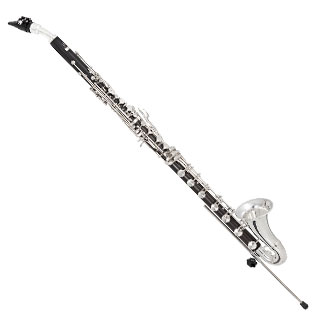
Today, the basset horn is considered a rare gem among woodwind instruments. While it may not be a common site on the modern orchestral stage, it continues to hold a special place in the hearts of music enthusiasts, historians, and those seeking to explore the vast array of instruments that have shaped the musical landscape over the centuries.
Learn more about the basset horn in a conversation with Houston Symphony clarinetists Christian Schubert and Bass Clarinet and Clarinet Tassie & Constantine S. Nicandros Chair Alexander Potiomkin.
Join us at Jones Hall this season to see how many exciting and uncommon instruments you can find on stage!

